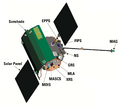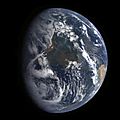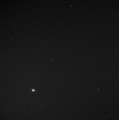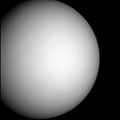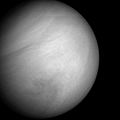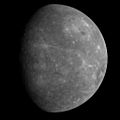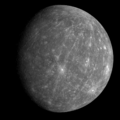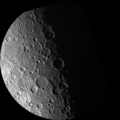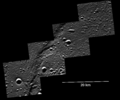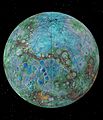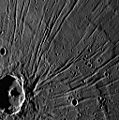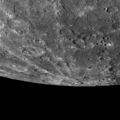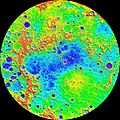MESSENGER facts for kids
| MESSENGER | |
|---|---|
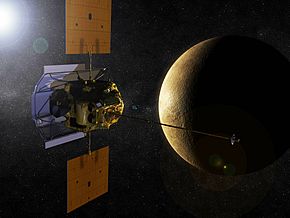 An artist's picture of MESSENGER orbiting Mercury |
|
| Organization: | NASA / APL |
| Mission type: | Flyby / Orbiter |
| Satellite of: | Mercury |
| Launch date: | August 3, 2004 |
| Launch vehicle: | Boeing Delta II |
| Launch site: | Cape Canaveral Air Force Station |
Quick facts for kids edit |
|
MESSENGER was a special robot spacecraft. It was sent by NASA and APL to study the planet Mercury. Its full name was MErcury Surface, Space ENvironment, GEochemistry and Ranging. This amazing mission lasted for almost 11 years!
Contents
What Was MESSENGER?
MESSENGER was an unmanned spacecraft. This means no people were on board. Its main job was to orbit Mercury. It collected information about the planet. It helped scientists learn about Mercury's surface, space environment, and what it's made of.
Journey to Mercury
MESSENGER was launched on August 3, 2004. It took off from Cape Canaveral Air Force Station. It rode into space on a Boeing Delta II rocket.
After launch, the spacecraft had a long journey. It did several "fly-bys." This means it flew close to other planets. It used their gravity to gain speed. This helped it get on the right path to Mercury. It also performed "deep space maneuvers." These were small engine burns. They helped guide the spacecraft.
Exploring Mercury
MESSENGER made its first close pass by Mercury on January 14, 2008. By then, it had mapped 30% of the planet. It made another pass in 2009.
On March 18, 2011, MESSENGER finally began to orbit Mercury. This was a big moment! It meant the spacecraft could study the planet up close. By March 2013, it had mapped 100% of Mercury's surface. The probe kept sending back important information.
End of the Mission
MESSENGER continued its studies for several more years. Its fuel started to run low. On April 30, 2015, the mission came to an end. MESSENGER crashed into Mercury. It crashed near a crater called Janáček. The mission was a huge success. It taught us so much about Mercury.
Images for kids
-
MESSENGER captured a near-complete portrait of the Solar System during November 2010. -
A suited worker looks over the hydrazine fuel supply to be loaded in MESSENGER.
-
Charles Bolden and colleagues wait for news from the MESSENGER probe.
-
A monochrome image of Mercury from MESSENGER, with Warhol at center.
-
A MESSENGER image of Mercury shows previously undetected fault scarps— cliff-like landforms resembling stairs that are small enough that scientists believe they are geologically young. This shows that Mercury is still contracting, and that Earth is not the only tectonically active Solar System planet.
-
Northern hemisphere topography from MLA data shows a 10 km vertical range: high (red); low (purple).
-
MASCS spectral scan of Mercury's surface.
See also
 In Spanish: MESSENGER para niños
In Spanish: MESSENGER para niños


